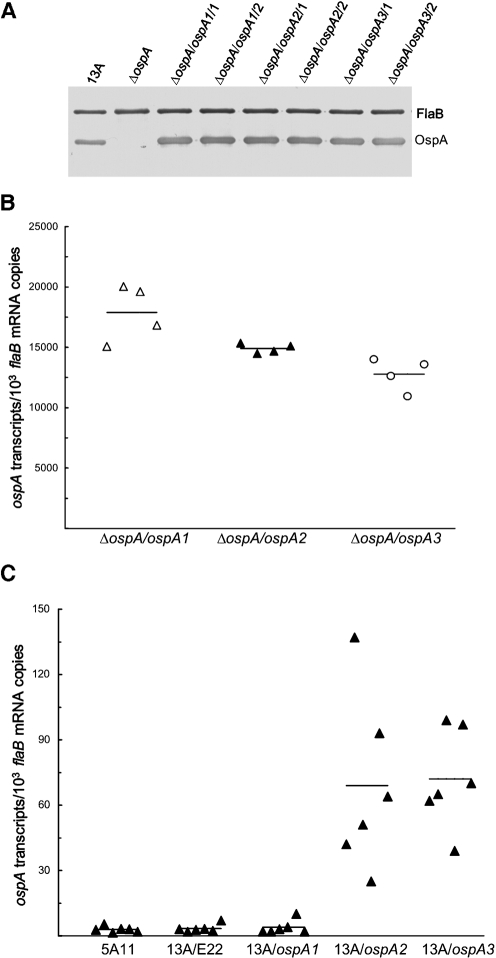Fig. 3.
The presence of DRs and the T-rich region enhances ospA expression in vitro but reduces expression in mice. (A) Restoration of OspA synthesis resulting from introduction of a construct. 13A, ΔospA, ΔospA/ospA1/1, ΔospA/ospA1/2, ΔospA/ospA2/1, ΔospA/ospA2/2, ΔospA/ospA3/1 and ΔospA/ospA3/2 spirochaetes were harvested at late-exponential phase and subjected to immunoblot analysis, probed with a mixture of FlaB and OspA mAbs. (B) Deletion of cisI and the T-rich region causes reduced ospA expression in vitro. ΔospA/ospA1/1, ΔospA/ospA1/2, ΔospA/ospA2/1, ΔospA/ospA2/2, ΔospA/ospA3/1 and ΔospA/ospA3/2 spirochaetes were harvested at late-exponential phase in duplicate. RNA was prepared and analysed for ospA and flaB expression by RT-qPCR. The expression activity is presented as ospA mRNA copy numbers per 103 flaB transcripts. For comparison, the subgroups were combined into three groups: ΔospA/ospA1/1 and ΔospA/ospA1/2, ΔospA/ospA2/1 and ΔospA/ospA2/2, and ΔospA/ospA3/1 and ΔospA/ospA3/2. The mean copy numbers (horizontal lines) for each group are presented. (C) The sequence of DRs is involved in repressing ospA expression in vivo. Subgroups of three SCID mice were inoculated with clone 13A/ospA1/1, 13A/ospA1/2, 13A/ospA2/1, 13A/ospA2/2, 13A/ospA3/1 or 13A/ospA3/2, and an additional 12 mice were infected with clones 5A11 and 13A/E22/C. All animals were euthanized 1 month later. RNA was extracted from skin specimens and quantified for flaB and ospA mRNAs by RT-qPCR. Data are presented as ospA transcripts per 103 flaB mRNA copies in five groups (genotypes including 5A11, 13A/E22, 13A/ospA1, 13A/ospA2 and 13A/ospA3). The means (horizontal lines) for each group are also presented.

